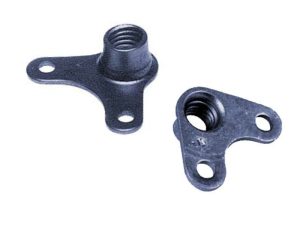
Nuts and nutplates are two types of fasteners with internal threading. They are used in conjunction with fasteners that feature external threading, such as a bolt. Airplanes often feature nuts and nutplates to secure the ends of bolts. While used for similar purposes, though, nuts and nutplates aren’t the same.
What Are Nuts?
Nuts are fasteners with internal threading. They consist of a threaded hole, which supports a fastener with external threading like a bolt. Nuts are used in conjunction with other fasteners to hold multiple parts together. They will hold the parts with which they are used together.
You can insert a bolt through two parts. To prevent the parts from separating from each other, you can twist a nut onto the end of the bolt. The nut will press against the back of the parts, whereas the head of the bolt will press against the front of the parts.
What Are Nutplates?
Nutplates are fasteners consisting of a built-in nut and a mountable frame. They are typically made of stamped metal. Nutplates feature a nut — a hole with interior threading — and a frame or plate.
You can use nutplates in conjunction with bolts. Like regular nuts, nutplates feature a threaded hole, so they support fasteners with external threading. Nutplates simply feature a frame or plate that you can mount to a given surface.
Differences Between Nuts and Nutplates
Nuts and nutplates may both feature internal threading, but they are used in different ways. You can twist a nut directly onto the back of a threaded fastener. Before using a nutplate, on the other hand, you’ll typically have to mount it.
Only nutplates require mounting. Nutplates are distinguished from nuts by the presence of a frame or plate. You can mount the with rivets. In addition to a central threaded hole, nutplates feature a set of holes in the frame or plate. These holes are designed to accommodate rivets. You can mount a nutplate on a given surface by inserting rivets through these holes. The rivets will hold the nutplate in place.
There are also different types of nutplates, such as fixed and floating. Fixed anchor nuts feature a stationary nut. The nut won’t move after the fixed anchor nut has been mounted to a surface. Floating anchor nuts feature a moveable nut. After a floating anchor nut has been mounted to a surface, the built-in nut will move slightly for positioning purposes.



